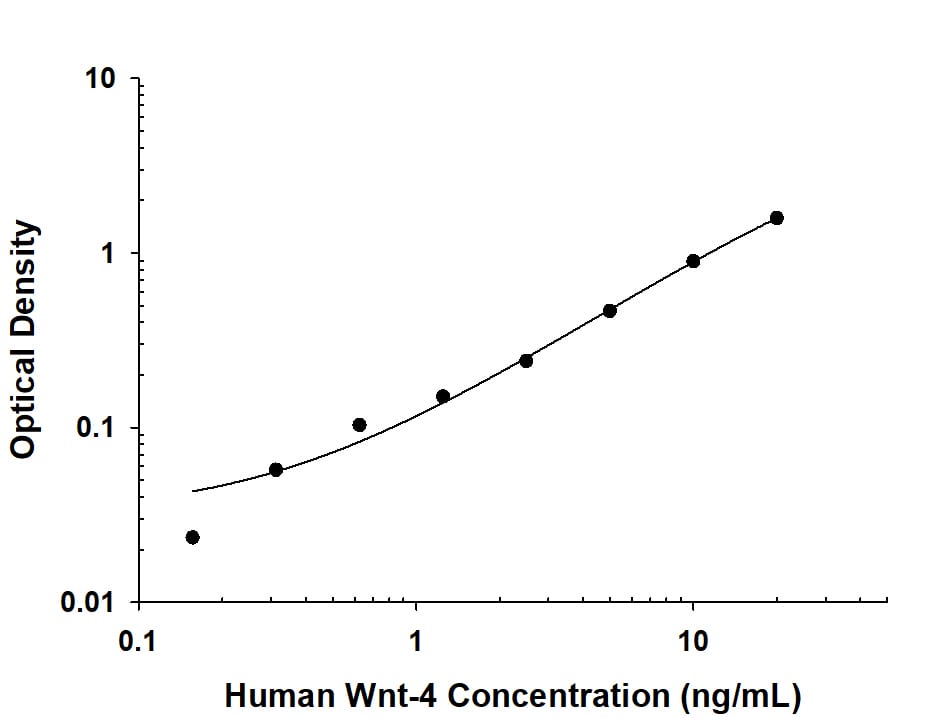Human Wnt-4 Antibody
R&D Systems, part of Bio-Techne | Catalog # AF6076

Key Product Details
Species Reactivity
Applications
Label
Antibody Source
Product Specifications
Immunogen
Ser23-Arg351
Accession # P56705
Specificity
Clonality
Host
Isotype
Scientific Data Images for Human Wnt-4 Antibody
Human Wnt-4 ELISA Standard Curve.
Recombinant Human Wnt-4 protein was serially diluted 2-fold and captured by Rat Anti-Human/Mouse Wnt-4 Monoclonal Antibody (MAB475) coated on a Clear Polystyrene Microplate (DY990). Sheep Anti-Human Wnt-4 Antigen Affinity-purified Polyclonal Antibody (Catalog # AF6076) was biotinylated and incubated with the protein captured on the plate. Detection of the standard curve was achieved by incubating Streptavidin-HRP (DY998) followed by Substrate Solution (DY999) and stopping the enzymatic reaction with Stop Solution (DY994).Human Wnt-4 ELISA Standard Curve.
Recombinant Human Wnt-4 protein was serially diluted 2-fold and captured by Rat Anti-Human/Mouse Wnt-4 Monoclonal Antibody (MAB4751 coated on a Clear Polystyrene Microplate (DY990). Sheep Anti-Human Wnt-4 Antigen Affinity-purified Polyclonal Antibody (Catalog # AF6076) was biotinylated and incubated with the protein captured on the plate. Detection of the standard curve was achieved by incubating Streptavidin-HRP (DY998) followed by Substrate Solution (DY999) and stopping the enzymatic reaction with Stop Solution (DY994).Applications for Human Wnt-4 Antibody
ELISA
This antibody functions as an ELISA detection antibody when paired with Rat Anti-Human/Mouse Wnt‑4 Monoclonal Antibody (Catalog # MAB475) or Rat Anti-Human/Mouse Wnt‑4 Monoclonal Antibody (Catalog # MAB4751) .
This product is intended for assay development on various assay platforms requiring antibody pairs.
Formulation, Preparation, and Storage
Purification
Reconstitution
Formulation
Shipping
Stability & Storage
- 12 months from date of receipt, -20 to -70 °C as supplied.
- 1 month, 2 to 8 °C under sterile conditions after reconstitution.
- 6 months, -20 to -70 °C under sterile conditions after reconstitution.
Background: Wnt-4
Wnt-4 is a 38‑42 kDa member of the Wnt family of secreted glycoproteins, which act as short-range signaling molecules via Frizzled receptors and a cascade of intracellular signals in vertebrate embryogenesis (1‑2). Human Wnt-4 is synthesized as a 351 amino acid (aa) precursor with a 22 aa signal sequence and a 329 aa mature chain. The mature chain contains two potential sites for N-linked glycosylation. Relative to other members of the Wnt family, Wnt-4 contains 83 conserved aa, including 21 cysteines (1). Mature human Wnt-4 shares 99%, 98% and 99% aa sequence identity with mature mouse, rat and canine Wnt-4, respectively. Wnt-4 has been shown to play a critical role in the development of the reproductive system and in the formation of the kidneys, adrenals, pituitary gland, and mammary tissues (3‑6). In the development of the reproductive system, Wnt-4 expression is down‑regulated in the developing gonad after E11.5, although it persists in the developing ovary (2, 6). Targeted deletion of Wnt-4 results in masculinization of XX mice, with rudimentary development of the masculine internal (Wolffian) ducts and degeneration of the female (Mullerian) reproductive tract (2, 6). In addition to its involvement in urogenital development, Wnt-4 is also expressed in the perichondrium of the long bones (7), and promotes osteoblast differentiation (8). Wnt-4 may also be associated with abnormal proliferation in human breast tissue (9). In humans, mutations in Wnt-4 are the cause of SERKAL syndrome, a syndrome consisting of female to male sex reversal, renal, adrenal, and lung dysgenesis, and developmental defects (3), and Rokitansky-Kuster-Hauser syndrome, which is characterized by utero-vaginal atresia in otherwise phenotypically normal females with normal 46, XX karyotype (10).
References
- Gavin, B.J. et al. (1990) Genes Dev. 4:2319.
- Jordan, B.K. et al. (2001) Am. J. Hum. Genet. 68:1102.
- Mandel, H. et al. (2008) Am. J. Hum. Genet. 82:39.
- Bernard, P. and V.R. Harley (2007) Int. J. Biochem. Cell Biol. 39:31.
- Kuulasmaa, T. et al. (2008) Horm. Metab. Res. 40:668.
- Vainio, S. et al. (1999) Nature 397:405.
- Gao, X. (2004) Genes Dev. 18:2404.
- Chang, J. et al. (2007) J. Biol. Chem. 282:30938.
- Huguet, E.L. et al. (1994) Cancer Res. 54:2615.
- Philibert, P. et al. (2008) J. Clin. Endocrinol. Metab. 93:895.
Long Name
Alternate Names
Gene Symbol
UniProt
Additional Wnt-4 Products
Product Documents for Human Wnt-4 Antibody
Product Specific Notices for Human Wnt-4 Antibody
For research use only

